Learning and Development Interventions for Red Telecom Team Leaders
VerifiedAdded on 2023/06/03
|11
|2746
|90
AI Summary
This report proposes a learning plan for team leaders of Customer Resolution Department at Red Telecom to achieve the predefined goals of General Manager. The report discusses the competencies a team leader should possess and theories integrated in the L&D proposal.
Contribute Materials
Your contribution can guide someone’s learning journey. Share your
documents today.
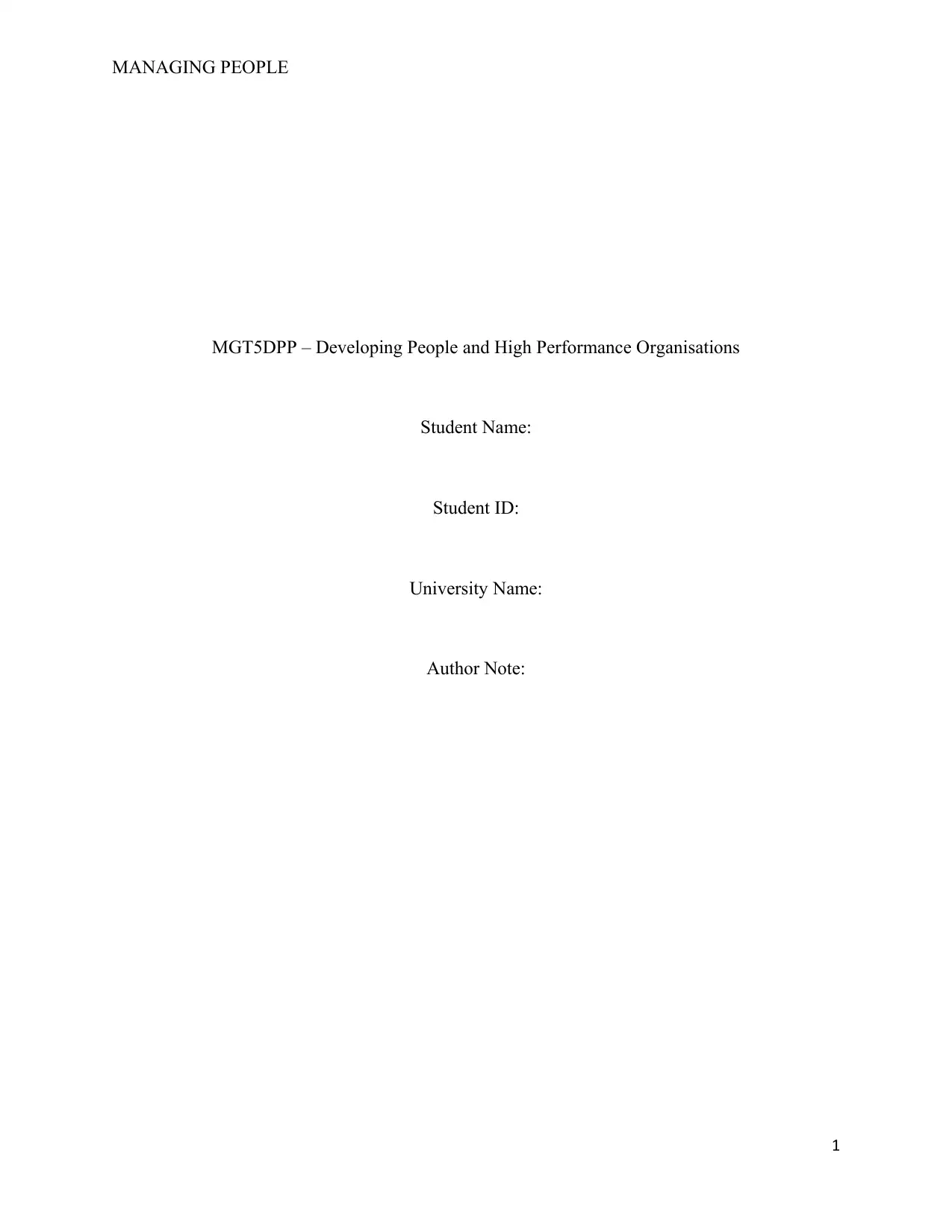
MANAGING PEOPLE
MGT5DPP – Developing People and High Performance Organisations
Student Name:
Student ID:
University Name:
Author Note:
1
MGT5DPP – Developing People and High Performance Organisations
Student Name:
Student ID:
University Name:
Author Note:
1
Secure Best Marks with AI Grader
Need help grading? Try our AI Grader for instant feedback on your assignments.
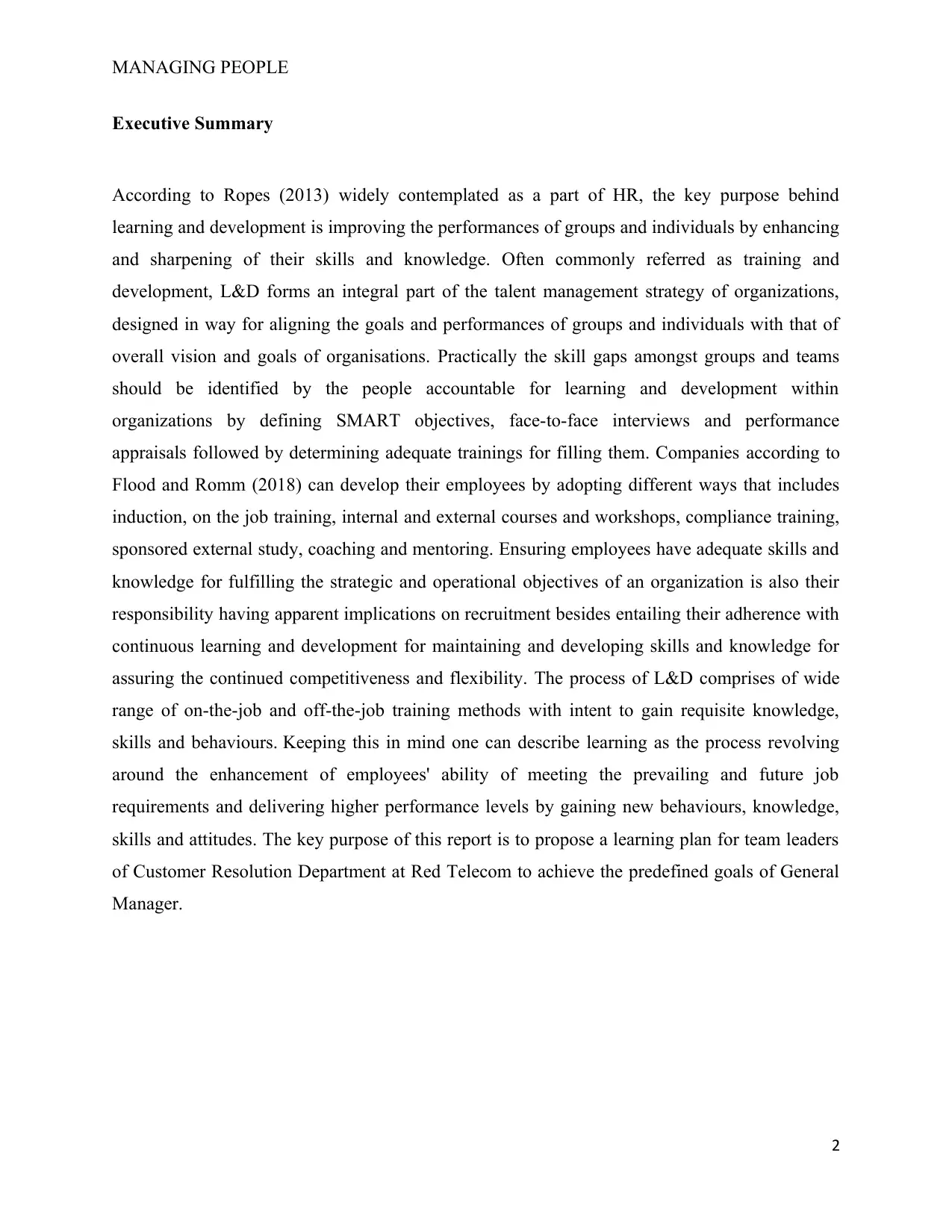
MANAGING PEOPLE
Executive Summary
According to Ropes (2013) widely contemplated as a part of HR, the key purpose behind
learning and development is improving the performances of groups and individuals by enhancing
and sharpening of their skills and knowledge. Often commonly referred as training and
development, L&D forms an integral part of the talent management strategy of organizations,
designed in way for aligning the goals and performances of groups and individuals with that of
overall vision and goals of organisations. Practically the skill gaps amongst groups and teams
should be identified by the people accountable for learning and development within
organizations by defining SMART objectives, face-to-face interviews and performance
appraisals followed by determining adequate trainings for filling them. Companies according to
Flood and Romm (2018) can develop their employees by adopting different ways that includes
induction, on the job training, internal and external courses and workshops, compliance training,
sponsored external study, coaching and mentoring. Ensuring employees have adequate skills and
knowledge for fulfilling the strategic and operational objectives of an organization is also their
responsibility having apparent implications on recruitment besides entailing their adherence with
continuous learning and development for maintaining and developing skills and knowledge for
assuring the continued competitiveness and flexibility. The process of L&D comprises of wide
range of on-the-job and off-the-job training methods with intent to gain requisite knowledge,
skills and behaviours. Keeping this in mind one can describe learning as the process revolving
around the enhancement of employees' ability of meeting the prevailing and future job
requirements and delivering higher performance levels by gaining new behaviours, knowledge,
skills and attitudes. The key purpose of this report is to propose a learning plan for team leaders
of Customer Resolution Department at Red Telecom to achieve the predefined goals of General
Manager.
2
Executive Summary
According to Ropes (2013) widely contemplated as a part of HR, the key purpose behind
learning and development is improving the performances of groups and individuals by enhancing
and sharpening of their skills and knowledge. Often commonly referred as training and
development, L&D forms an integral part of the talent management strategy of organizations,
designed in way for aligning the goals and performances of groups and individuals with that of
overall vision and goals of organisations. Practically the skill gaps amongst groups and teams
should be identified by the people accountable for learning and development within
organizations by defining SMART objectives, face-to-face interviews and performance
appraisals followed by determining adequate trainings for filling them. Companies according to
Flood and Romm (2018) can develop their employees by adopting different ways that includes
induction, on the job training, internal and external courses and workshops, compliance training,
sponsored external study, coaching and mentoring. Ensuring employees have adequate skills and
knowledge for fulfilling the strategic and operational objectives of an organization is also their
responsibility having apparent implications on recruitment besides entailing their adherence with
continuous learning and development for maintaining and developing skills and knowledge for
assuring the continued competitiveness and flexibility. The process of L&D comprises of wide
range of on-the-job and off-the-job training methods with intent to gain requisite knowledge,
skills and behaviours. Keeping this in mind one can describe learning as the process revolving
around the enhancement of employees' ability of meeting the prevailing and future job
requirements and delivering higher performance levels by gaining new behaviours, knowledge,
skills and attitudes. The key purpose of this report is to propose a learning plan for team leaders
of Customer Resolution Department at Red Telecom to achieve the predefined goals of General
Manager.
2
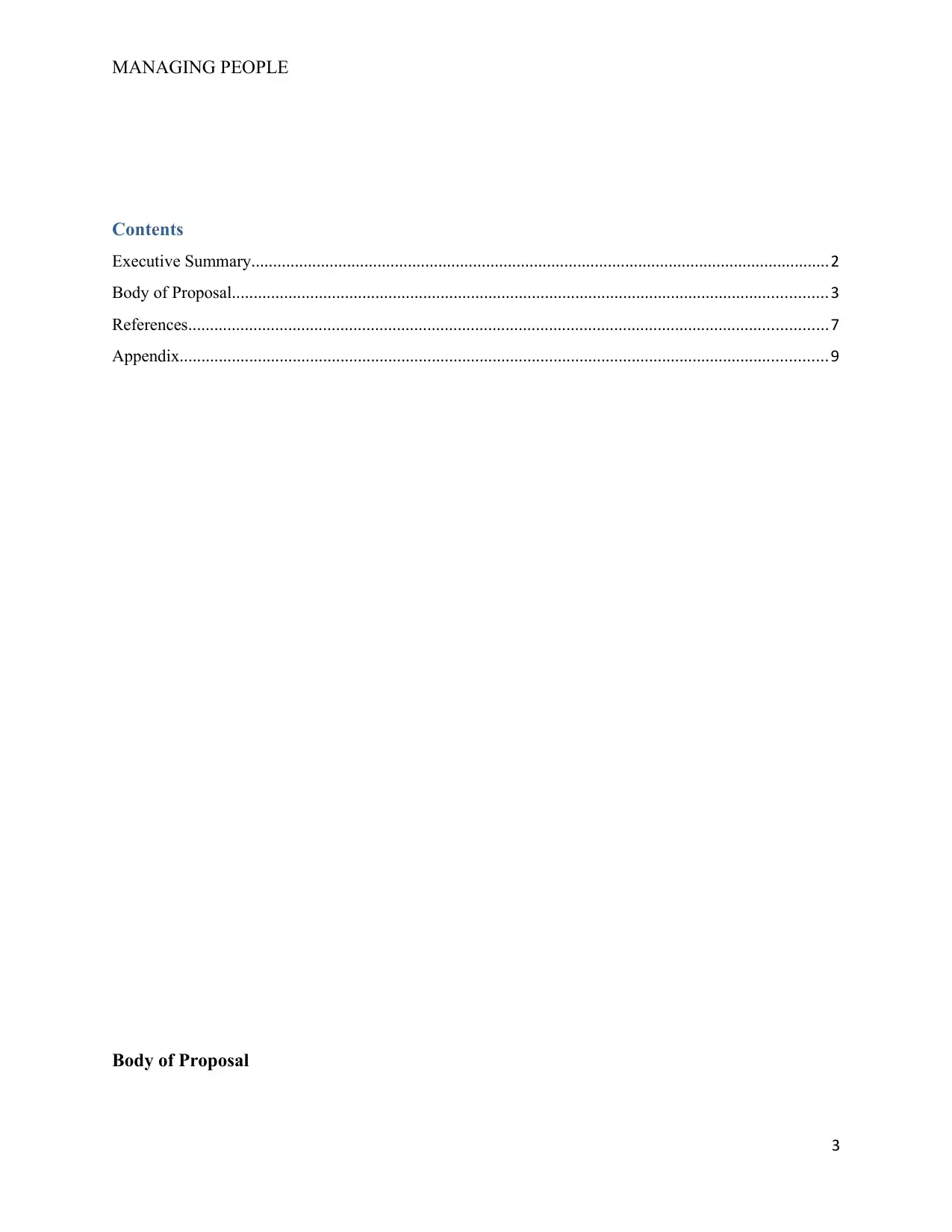
MANAGING PEOPLE
Contents
Executive Summary.....................................................................................................................................2
Body of Proposal.........................................................................................................................................3
References...................................................................................................................................................7
Appendix.....................................................................................................................................................9
Body of Proposal
3
Contents
Executive Summary.....................................................................................................................................2
Body of Proposal.........................................................................................................................................3
References...................................................................................................................................................7
Appendix.....................................................................................................................................................9
Body of Proposal
3
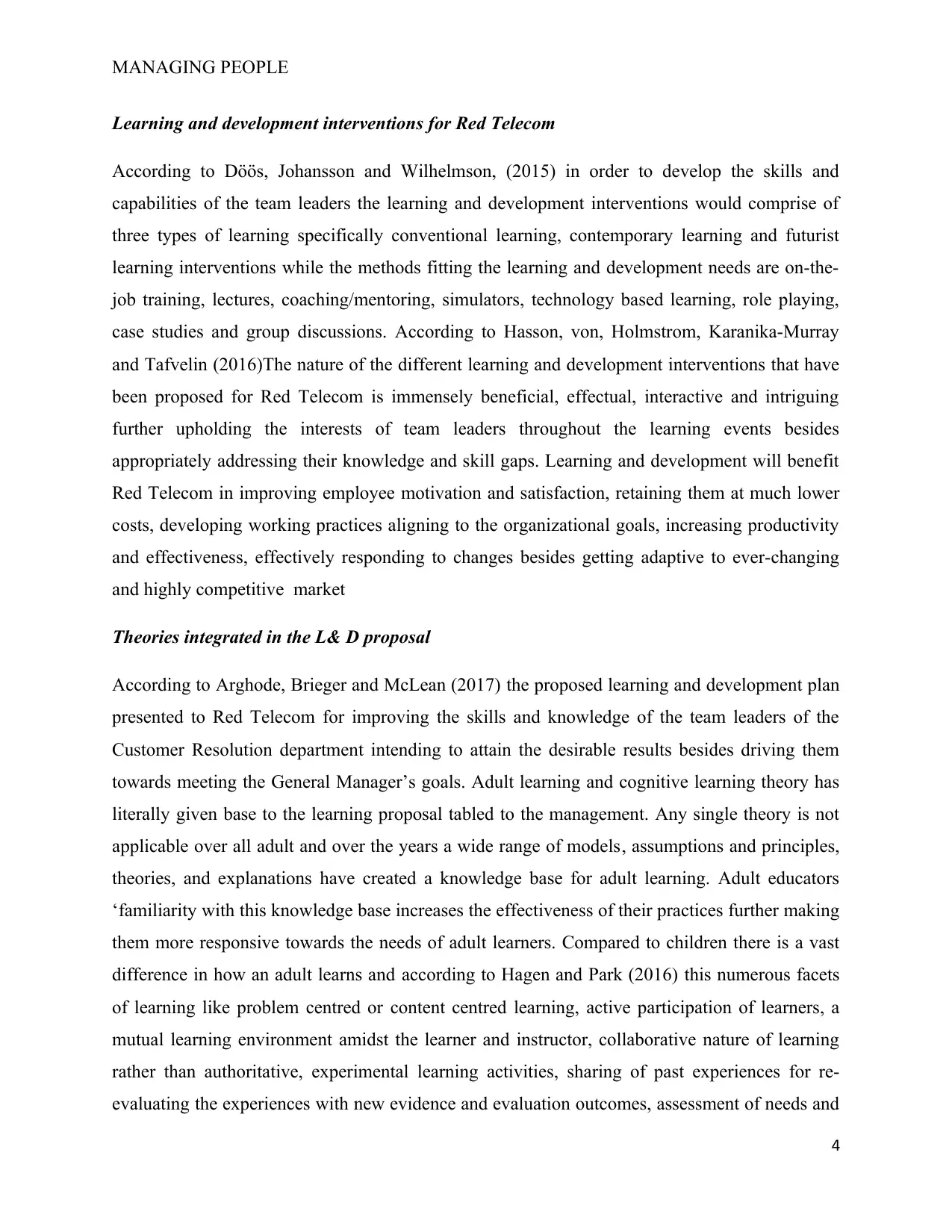
MANAGING PEOPLE
Learning and development interventions for Red Telecom
According to Döös, Johansson and Wilhelmson, (2015) in order to develop the skills and
capabilities of the team leaders the learning and development interventions would comprise of
three types of learning specifically conventional learning, contemporary learning and futurist
learning interventions while the methods fitting the learning and development needs are on-the-
job training, lectures, coaching/mentoring, simulators, technology based learning, role playing,
case studies and group discussions. According to Hasson, von, Holmstrom, Karanika-Murray
and Tafvelin (2016)The nature of the different learning and development interventions that have
been proposed for Red Telecom is immensely beneficial, effectual, interactive and intriguing
further upholding the interests of team leaders throughout the learning events besides
appropriately addressing their knowledge and skill gaps. Learning and development will benefit
Red Telecom in improving employee motivation and satisfaction, retaining them at much lower
costs, developing working practices aligning to the organizational goals, increasing productivity
and effectiveness, effectively responding to changes besides getting adaptive to ever-changing
and highly competitive market
Theories integrated in the L& D proposal
According to Arghode, Brieger and McLean (2017) the proposed learning and development plan
presented to Red Telecom for improving the skills and knowledge of the team leaders of the
Customer Resolution department intending to attain the desirable results besides driving them
towards meeting the General Manager’s goals. Adult learning and cognitive learning theory has
literally given base to the learning proposal tabled to the management. Any single theory is not
applicable over all adult and over the years a wide range of models, assumptions and principles,
theories, and explanations have created a knowledge base for adult learning. Adult educators
‘familiarity with this knowledge base increases the effectiveness of their practices further making
them more responsive towards the needs of adult learners. Compared to children there is a vast
difference in how an adult learns and according to Hagen and Park (2016) this numerous facets
of learning like problem centred or content centred learning, active participation of learners, a
mutual learning environment amidst the learner and instructor, collaborative nature of learning
rather than authoritative, experimental learning activities, sharing of past experiences for re-
evaluating the experiences with new evidence and evaluation outcomes, assessment of needs and
4
Learning and development interventions for Red Telecom
According to Döös, Johansson and Wilhelmson, (2015) in order to develop the skills and
capabilities of the team leaders the learning and development interventions would comprise of
three types of learning specifically conventional learning, contemporary learning and futurist
learning interventions while the methods fitting the learning and development needs are on-the-
job training, lectures, coaching/mentoring, simulators, technology based learning, role playing,
case studies and group discussions. According to Hasson, von, Holmstrom, Karanika-Murray
and Tafvelin (2016)The nature of the different learning and development interventions that have
been proposed for Red Telecom is immensely beneficial, effectual, interactive and intriguing
further upholding the interests of team leaders throughout the learning events besides
appropriately addressing their knowledge and skill gaps. Learning and development will benefit
Red Telecom in improving employee motivation and satisfaction, retaining them at much lower
costs, developing working practices aligning to the organizational goals, increasing productivity
and effectiveness, effectively responding to changes besides getting adaptive to ever-changing
and highly competitive market
Theories integrated in the L& D proposal
According to Arghode, Brieger and McLean (2017) the proposed learning and development plan
presented to Red Telecom for improving the skills and knowledge of the team leaders of the
Customer Resolution department intending to attain the desirable results besides driving them
towards meeting the General Manager’s goals. Adult learning and cognitive learning theory has
literally given base to the learning proposal tabled to the management. Any single theory is not
applicable over all adult and over the years a wide range of models, assumptions and principles,
theories, and explanations have created a knowledge base for adult learning. Adult educators
‘familiarity with this knowledge base increases the effectiveness of their practices further making
them more responsive towards the needs of adult learners. Compared to children there is a vast
difference in how an adult learns and according to Hagen and Park (2016) this numerous facets
of learning like problem centred or content centred learning, active participation of learners, a
mutual learning environment amidst the learner and instructor, collaborative nature of learning
rather than authoritative, experimental learning activities, sharing of past experiences for re-
evaluating the experiences with new evidence and evaluation outcomes, assessment of needs and
4
Secure Best Marks with AI Grader
Need help grading? Try our AI Grader for instant feedback on your assignments.
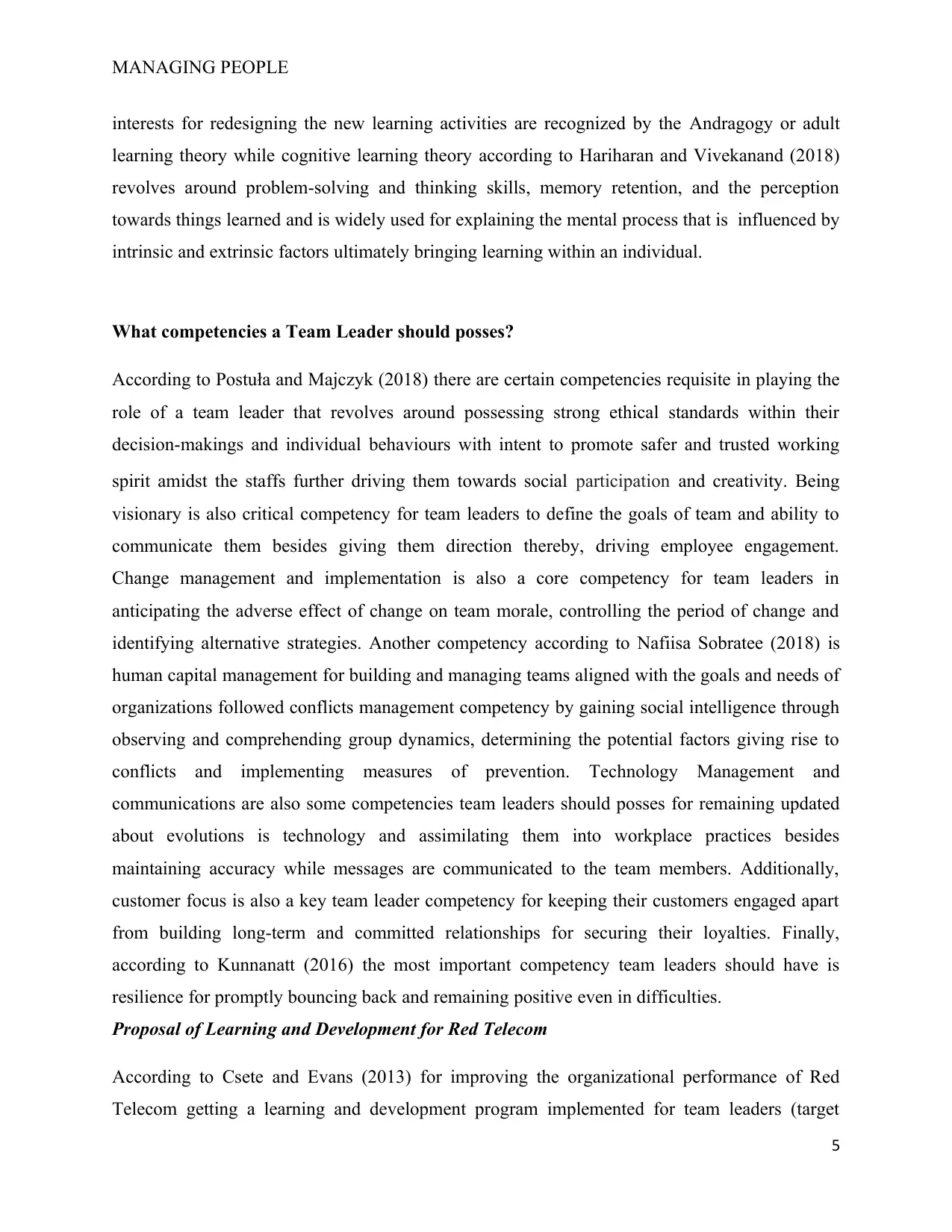
MANAGING PEOPLE
interests for redesigning the new learning activities are recognized by the Andragogy or adult
learning theory while cognitive learning theory according to Hariharan and Vivekanand (2018)
revolves around problem-solving and thinking skills, memory retention, and the perception
towards things learned and is widely used for explaining the mental process that is influenced by
intrinsic and extrinsic factors ultimately bringing learning within an individual.
What competencies a Team Leader should posses?
According to Postuła and Majczyk (2018) there are certain competencies requisite in playing the
role of a team leader that revolves around possessing strong ethical standards within their
decision-makings and individual behaviours with intent to promote safer and trusted working
spirit amidst the staffs further driving them towards social participation and creativity. Being
visionary is also critical competency for team leaders to define the goals of team and ability to
communicate them besides giving them direction thereby, driving employee engagement.
Change management and implementation is also a core competency for team leaders in
anticipating the adverse effect of change on team morale, controlling the period of change and
identifying alternative strategies. Another competency according to Nafiisa Sobratee (2018) is
human capital management for building and managing teams aligned with the goals and needs of
organizations followed conflicts management competency by gaining social intelligence through
observing and comprehending group dynamics, determining the potential factors giving rise to
conflicts and implementing measures of prevention. Technology Management and
communications are also some competencies team leaders should posses for remaining updated
about evolutions is technology and assimilating them into workplace practices besides
maintaining accuracy while messages are communicated to the team members. Additionally,
customer focus is also a key team leader competency for keeping their customers engaged apart
from building long-term and committed relationships for securing their loyalties. Finally,
according to Kunnanatt (2016) the most important competency team leaders should have is
resilience for promptly bouncing back and remaining positive even in difficulties.
Proposal of Learning and Development for Red Telecom
According to Csete and Evans (2013) for improving the organizational performance of Red
Telecom getting a learning and development program implemented for team leaders (target
5
interests for redesigning the new learning activities are recognized by the Andragogy or adult
learning theory while cognitive learning theory according to Hariharan and Vivekanand (2018)
revolves around problem-solving and thinking skills, memory retention, and the perception
towards things learned and is widely used for explaining the mental process that is influenced by
intrinsic and extrinsic factors ultimately bringing learning within an individual.
What competencies a Team Leader should posses?
According to Postuła and Majczyk (2018) there are certain competencies requisite in playing the
role of a team leader that revolves around possessing strong ethical standards within their
decision-makings and individual behaviours with intent to promote safer and trusted working
spirit amidst the staffs further driving them towards social participation and creativity. Being
visionary is also critical competency for team leaders to define the goals of team and ability to
communicate them besides giving them direction thereby, driving employee engagement.
Change management and implementation is also a core competency for team leaders in
anticipating the adverse effect of change on team morale, controlling the period of change and
identifying alternative strategies. Another competency according to Nafiisa Sobratee (2018) is
human capital management for building and managing teams aligned with the goals and needs of
organizations followed conflicts management competency by gaining social intelligence through
observing and comprehending group dynamics, determining the potential factors giving rise to
conflicts and implementing measures of prevention. Technology Management and
communications are also some competencies team leaders should posses for remaining updated
about evolutions is technology and assimilating them into workplace practices besides
maintaining accuracy while messages are communicated to the team members. Additionally,
customer focus is also a key team leader competency for keeping their customers engaged apart
from building long-term and committed relationships for securing their loyalties. Finally,
according to Kunnanatt (2016) the most important competency team leaders should have is
resilience for promptly bouncing back and remaining positive even in difficulties.
Proposal of Learning and Development for Red Telecom
According to Csete and Evans (2013) for improving the organizational performance of Red
Telecom getting a learning and development program implemented for team leaders (target
5
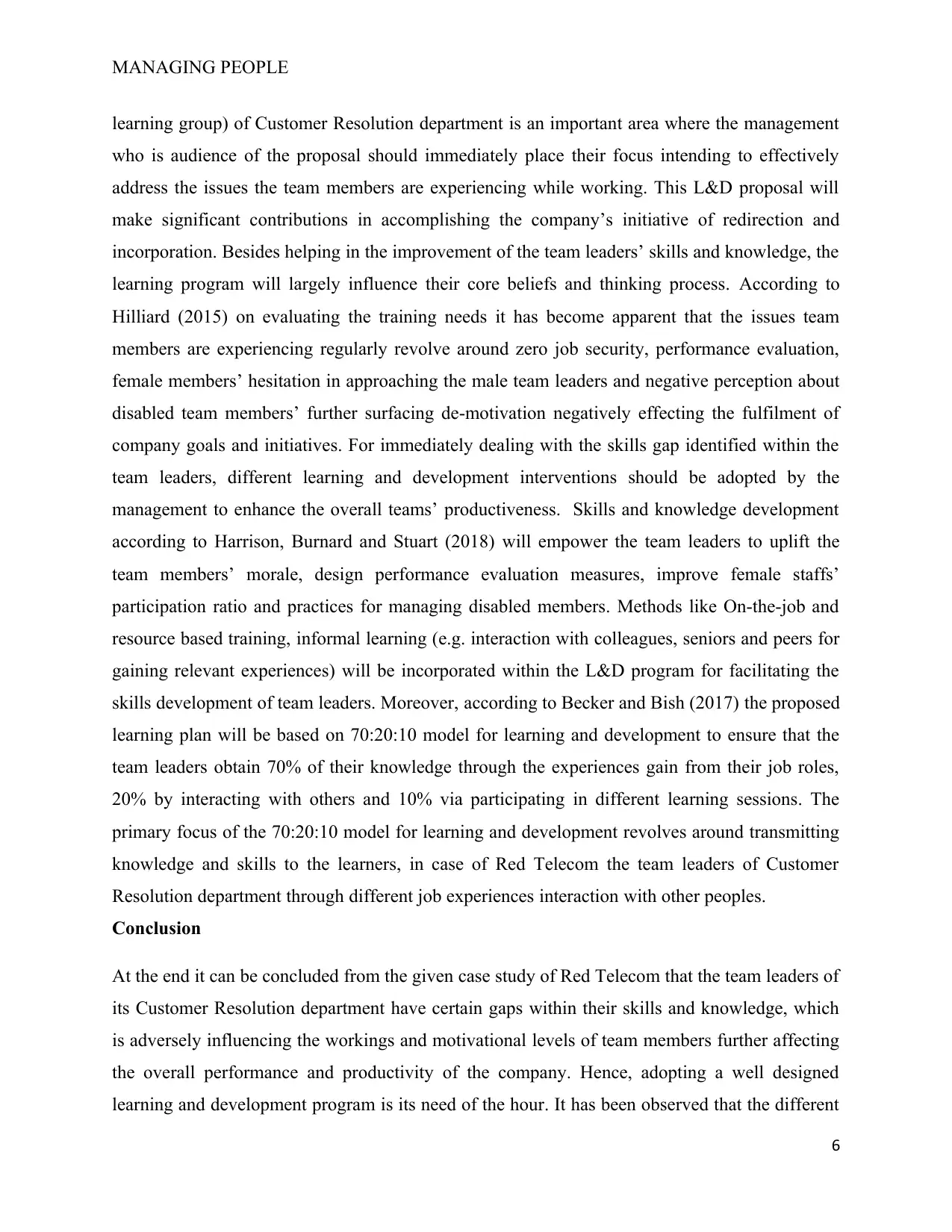
MANAGING PEOPLE
learning group) of Customer Resolution department is an important area where the management
who is audience of the proposal should immediately place their focus intending to effectively
address the issues the team members are experiencing while working. This L&D proposal will
make significant contributions in accomplishing the company’s initiative of redirection and
incorporation. Besides helping in the improvement of the team leaders’ skills and knowledge, the
learning program will largely influence their core beliefs and thinking process. According to
Hilliard (2015) on evaluating the training needs it has become apparent that the issues team
members are experiencing regularly revolve around zero job security, performance evaluation,
female members’ hesitation in approaching the male team leaders and negative perception about
disabled team members’ further surfacing de-motivation negatively effecting the fulfilment of
company goals and initiatives. For immediately dealing with the skills gap identified within the
team leaders, different learning and development interventions should be adopted by the
management to enhance the overall teams’ productiveness. Skills and knowledge development
according to Harrison, Burnard and Stuart (2018) will empower the team leaders to uplift the
team members’ morale, design performance evaluation measures, improve female staffs’
participation ratio and practices for managing disabled members. Methods like On-the-job and
resource based training, informal learning (e.g. interaction with colleagues, seniors and peers for
gaining relevant experiences) will be incorporated within the L&D program for facilitating the
skills development of team leaders. Moreover, according to Becker and Bish (2017) the proposed
learning plan will be based on 70:20:10 model for learning and development to ensure that the
team leaders obtain 70% of their knowledge through the experiences gain from their job roles,
20% by interacting with others and 10% via participating in different learning sessions. The
primary focus of the 70:20:10 model for learning and development revolves around transmitting
knowledge and skills to the learners, in case of Red Telecom the team leaders of Customer
Resolution department through different job experiences interaction with other peoples.
Conclusion
At the end it can be concluded from the given case study of Red Telecom that the team leaders of
its Customer Resolution department have certain gaps within their skills and knowledge, which
is adversely influencing the workings and motivational levels of team members further affecting
the overall performance and productivity of the company. Hence, adopting a well designed
learning and development program is its need of the hour. It has been observed that the different
6
learning group) of Customer Resolution department is an important area where the management
who is audience of the proposal should immediately place their focus intending to effectively
address the issues the team members are experiencing while working. This L&D proposal will
make significant contributions in accomplishing the company’s initiative of redirection and
incorporation. Besides helping in the improvement of the team leaders’ skills and knowledge, the
learning program will largely influence their core beliefs and thinking process. According to
Hilliard (2015) on evaluating the training needs it has become apparent that the issues team
members are experiencing regularly revolve around zero job security, performance evaluation,
female members’ hesitation in approaching the male team leaders and negative perception about
disabled team members’ further surfacing de-motivation negatively effecting the fulfilment of
company goals and initiatives. For immediately dealing with the skills gap identified within the
team leaders, different learning and development interventions should be adopted by the
management to enhance the overall teams’ productiveness. Skills and knowledge development
according to Harrison, Burnard and Stuart (2018) will empower the team leaders to uplift the
team members’ morale, design performance evaluation measures, improve female staffs’
participation ratio and practices for managing disabled members. Methods like On-the-job and
resource based training, informal learning (e.g. interaction with colleagues, seniors and peers for
gaining relevant experiences) will be incorporated within the L&D program for facilitating the
skills development of team leaders. Moreover, according to Becker and Bish (2017) the proposed
learning plan will be based on 70:20:10 model for learning and development to ensure that the
team leaders obtain 70% of their knowledge through the experiences gain from their job roles,
20% by interacting with others and 10% via participating in different learning sessions. The
primary focus of the 70:20:10 model for learning and development revolves around transmitting
knowledge and skills to the learners, in case of Red Telecom the team leaders of Customer
Resolution department through different job experiences interaction with other peoples.
Conclusion
At the end it can be concluded from the given case study of Red Telecom that the team leaders of
its Customer Resolution department have certain gaps within their skills and knowledge, which
is adversely influencing the workings and motivational levels of team members further affecting
the overall performance and productivity of the company. Hence, adopting a well designed
learning and development program is its need of the hour. It has been observed that the different
6
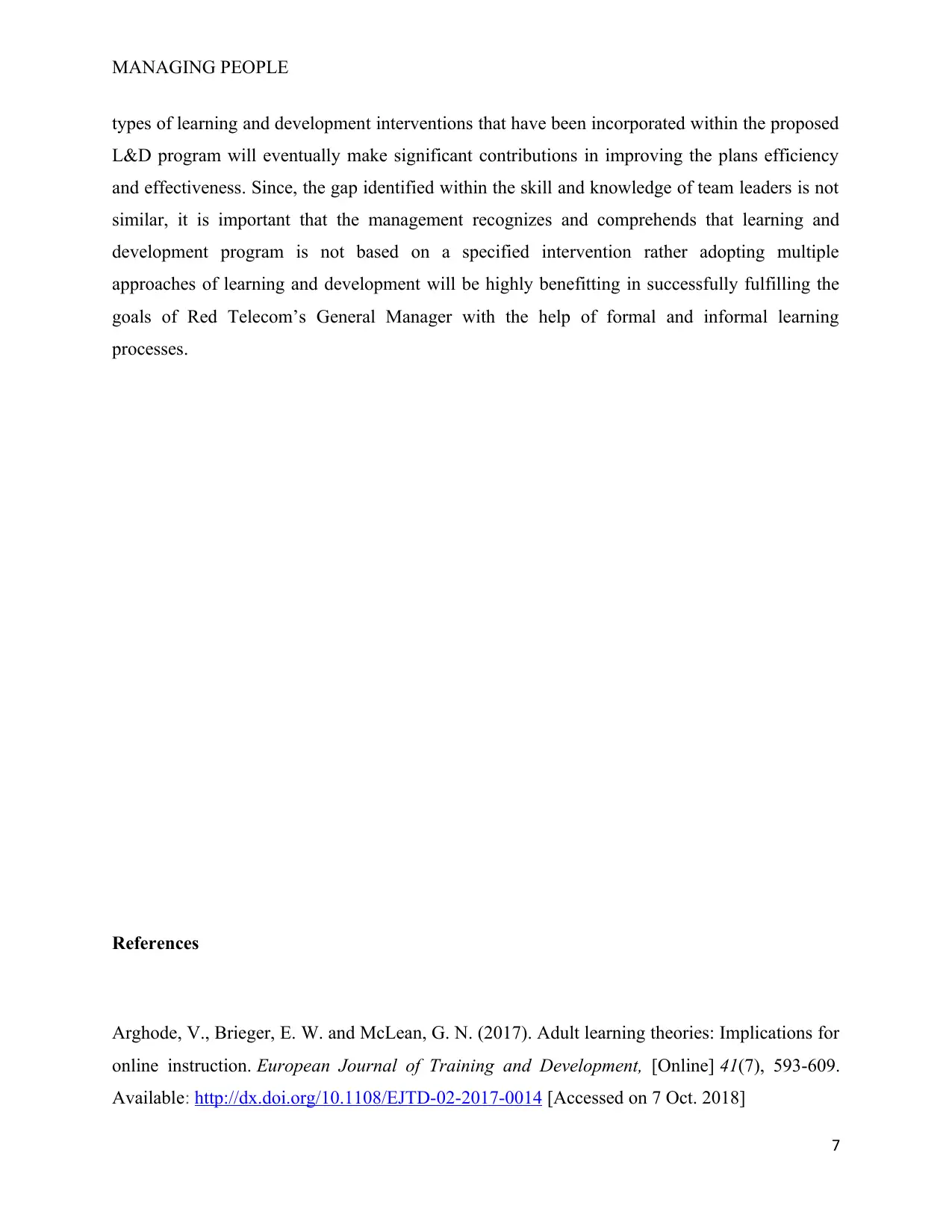
MANAGING PEOPLE
types of learning and development interventions that have been incorporated within the proposed
L&D program will eventually make significant contributions in improving the plans efficiency
and effectiveness. Since, the gap identified within the skill and knowledge of team leaders is not
similar, it is important that the management recognizes and comprehends that learning and
development program is not based on a specified intervention rather adopting multiple
approaches of learning and development will be highly benefitting in successfully fulfilling the
goals of Red Telecom’s General Manager with the help of formal and informal learning
processes.
References
Arghode, V., Brieger, E. W. and McLean, G. N. (2017). Adult learning theories: Implications for
online instruction. European Journal of Training and Development, [Online] 41(7), 593-609.
Available: http://dx.doi.org/10.1108/EJTD-02-2017-0014 [Accessed on 7 Oct. 2018]
7
types of learning and development interventions that have been incorporated within the proposed
L&D program will eventually make significant contributions in improving the plans efficiency
and effectiveness. Since, the gap identified within the skill and knowledge of team leaders is not
similar, it is important that the management recognizes and comprehends that learning and
development program is not based on a specified intervention rather adopting multiple
approaches of learning and development will be highly benefitting in successfully fulfilling the
goals of Red Telecom’s General Manager with the help of formal and informal learning
processes.
References
Arghode, V., Brieger, E. W. and McLean, G. N. (2017). Adult learning theories: Implications for
online instruction. European Journal of Training and Development, [Online] 41(7), 593-609.
Available: http://dx.doi.org/10.1108/EJTD-02-2017-0014 [Accessed on 7 Oct. 2018]
7
Paraphrase This Document
Need a fresh take? Get an instant paraphrase of this document with our AI Paraphraser
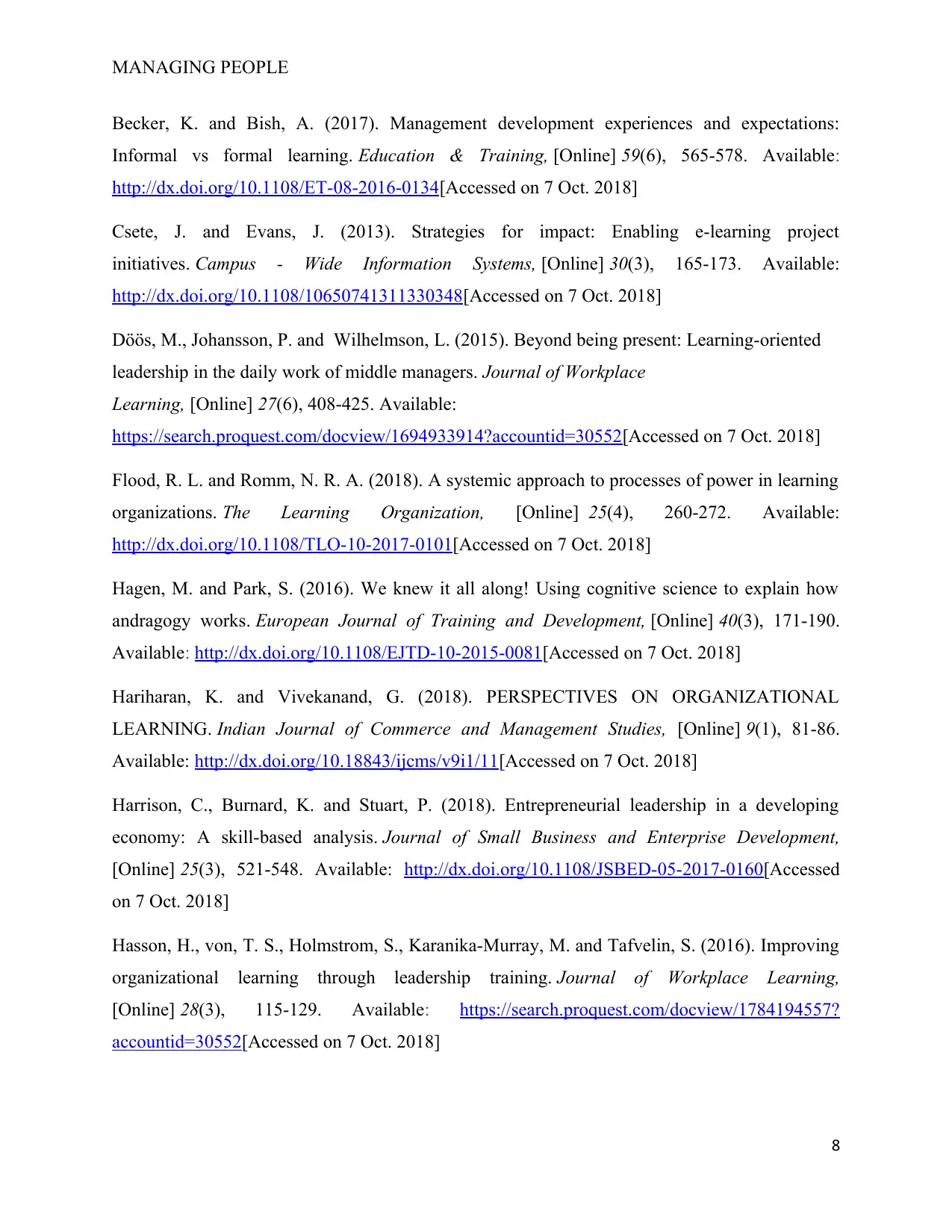
MANAGING PEOPLE
Becker, K. and Bish, A. (2017). Management development experiences and expectations:
Informal vs formal learning. Education & Training, [Online] 59(6), 565-578. Available:
http://dx.doi.org/10.1108/ET-08-2016-0134[Accessed on 7 Oct. 2018]
Csete, J. and Evans, J. (2013). Strategies for impact: Enabling e-learning project
initiatives. Campus - Wide Information Systems, [Online] 30(3), 165-173. Available:
http://dx.doi.org/10.1108/10650741311330348[Accessed on 7 Oct. 2018]
Döös, M., Johansson, P. and Wilhelmson, L. (2015). Beyond being present: Learning-oriented
leadership in the daily work of middle managers. Journal of Workplace
Learning, [Online] 27(6), 408-425. Available:
https://search.proquest.com/docview/1694933914?accountid=30552[Accessed on 7 Oct. 2018]
Flood, R. L. and Romm, N. R. A. (2018). A systemic approach to processes of power in learning
organizations. The Learning Organization, [Online] 25(4), 260-272. Available:
http://dx.doi.org/10.1108/TLO-10-2017-0101[Accessed on 7 Oct. 2018]
Hagen, M. and Park, S. (2016). We knew it all along! Using cognitive science to explain how
andragogy works. European Journal of Training and Development, [Online] 40(3), 171-190.
Available: http://dx.doi.org/10.1108/EJTD-10-2015-0081[Accessed on 7 Oct. 2018]
Hariharan, K. and Vivekanand, G. (2018). PERSPECTIVES ON ORGANIZATIONAL
LEARNING. Indian Journal of Commerce and Management Studies, [Online] 9(1), 81-86.
Available: http://dx.doi.org/10.18843/ijcms/v9i1/11[Accessed on 7 Oct. 2018]
Harrison, C., Burnard, K. and Stuart, P. (2018). Entrepreneurial leadership in a developing
economy: A skill-based analysis. Journal of Small Business and Enterprise Development,
[Online] 25(3), 521-548. Available: http://dx.doi.org/10.1108/JSBED-05-2017-0160[Accessed
on 7 Oct. 2018]
Hasson, H., von, T. S., Holmstrom, S., Karanika-Murray, M. and Tafvelin, S. (2016). Improving
organizational learning through leadership training. Journal of Workplace Learning,
[Online] 28(3), 115-129. Available: https://search.proquest.com/docview/1784194557?
accountid=30552[Accessed on 7 Oct. 2018]
8
Becker, K. and Bish, A. (2017). Management development experiences and expectations:
Informal vs formal learning. Education & Training, [Online] 59(6), 565-578. Available:
http://dx.doi.org/10.1108/ET-08-2016-0134[Accessed on 7 Oct. 2018]
Csete, J. and Evans, J. (2013). Strategies for impact: Enabling e-learning project
initiatives. Campus - Wide Information Systems, [Online] 30(3), 165-173. Available:
http://dx.doi.org/10.1108/10650741311330348[Accessed on 7 Oct. 2018]
Döös, M., Johansson, P. and Wilhelmson, L. (2015). Beyond being present: Learning-oriented
leadership in the daily work of middle managers. Journal of Workplace
Learning, [Online] 27(6), 408-425. Available:
https://search.proquest.com/docview/1694933914?accountid=30552[Accessed on 7 Oct. 2018]
Flood, R. L. and Romm, N. R. A. (2018). A systemic approach to processes of power in learning
organizations. The Learning Organization, [Online] 25(4), 260-272. Available:
http://dx.doi.org/10.1108/TLO-10-2017-0101[Accessed on 7 Oct. 2018]
Hagen, M. and Park, S. (2016). We knew it all along! Using cognitive science to explain how
andragogy works. European Journal of Training and Development, [Online] 40(3), 171-190.
Available: http://dx.doi.org/10.1108/EJTD-10-2015-0081[Accessed on 7 Oct. 2018]
Hariharan, K. and Vivekanand, G. (2018). PERSPECTIVES ON ORGANIZATIONAL
LEARNING. Indian Journal of Commerce and Management Studies, [Online] 9(1), 81-86.
Available: http://dx.doi.org/10.18843/ijcms/v9i1/11[Accessed on 7 Oct. 2018]
Harrison, C., Burnard, K. and Stuart, P. (2018). Entrepreneurial leadership in a developing
economy: A skill-based analysis. Journal of Small Business and Enterprise Development,
[Online] 25(3), 521-548. Available: http://dx.doi.org/10.1108/JSBED-05-2017-0160[Accessed
on 7 Oct. 2018]
Hasson, H., von, T. S., Holmstrom, S., Karanika-Murray, M. and Tafvelin, S. (2016). Improving
organizational learning through leadership training. Journal of Workplace Learning,
[Online] 28(3), 115-129. Available: https://search.proquest.com/docview/1784194557?
accountid=30552[Accessed on 7 Oct. 2018]
8
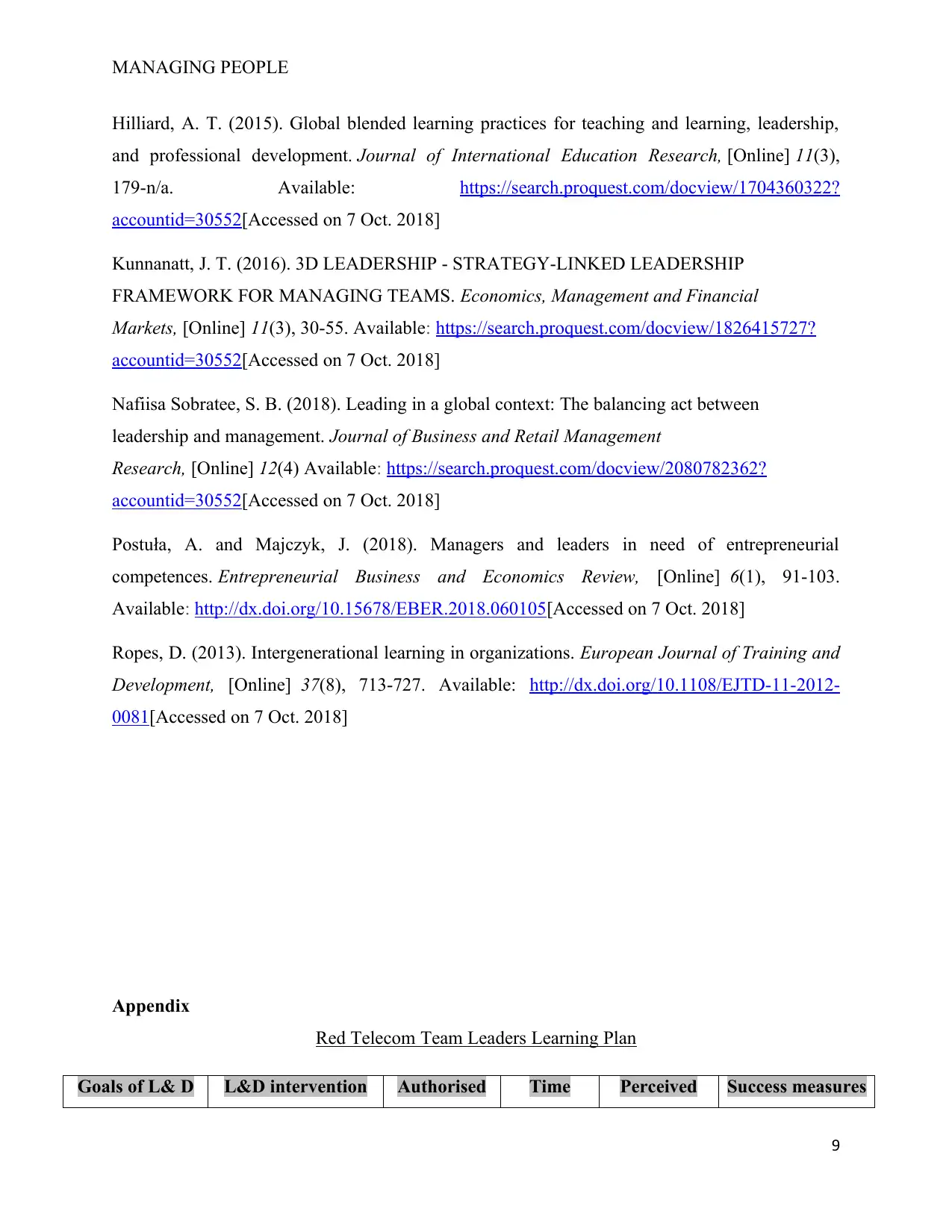
MANAGING PEOPLE
Hilliard, A. T. (2015). Global blended learning practices for teaching and learning, leadership,
and professional development. Journal of International Education Research, [Online] 11(3),
179-n/a. Available: https://search.proquest.com/docview/1704360322?
accountid=30552[Accessed on 7 Oct. 2018]
Kunnanatt, J. T. (2016). 3D LEADERSHIP - STRATEGY-LINKED LEADERSHIP
FRAMEWORK FOR MANAGING TEAMS. Economics, Management and Financial
Markets, [Online] 11(3), 30-55. Available: https://search.proquest.com/docview/1826415727?
accountid=30552[Accessed on 7 Oct. 2018]
Nafiisa Sobratee, S. B. (2018). Leading in a global context: The balancing act between
leadership and management. Journal of Business and Retail Management
Research, [Online] 12(4) Available: https://search.proquest.com/docview/2080782362?
accountid=30552[Accessed on 7 Oct. 2018]
Postuła, A. and Majczyk, J. (2018). Managers and leaders in need of entrepreneurial
competences. Entrepreneurial Business and Economics Review, [Online] 6(1), 91-103.
Available: http://dx.doi.org/10.15678/EBER.2018.060105[Accessed on 7 Oct. 2018]
Ropes, D. (2013). Intergenerational learning in organizations. European Journal of Training and
Development, [Online] 37(8), 713-727. Available: http://dx.doi.org/10.1108/EJTD-11-2012-
0081[Accessed on 7 Oct. 2018]
Appendix
Red Telecom Team Leaders Learning Plan
Goals of L& D L&D intervention Authorised Time Perceived Success measures
9
Hilliard, A. T. (2015). Global blended learning practices for teaching and learning, leadership,
and professional development. Journal of International Education Research, [Online] 11(3),
179-n/a. Available: https://search.proquest.com/docview/1704360322?
accountid=30552[Accessed on 7 Oct. 2018]
Kunnanatt, J. T. (2016). 3D LEADERSHIP - STRATEGY-LINKED LEADERSHIP
FRAMEWORK FOR MANAGING TEAMS. Economics, Management and Financial
Markets, [Online] 11(3), 30-55. Available: https://search.proquest.com/docview/1826415727?
accountid=30552[Accessed on 7 Oct. 2018]
Nafiisa Sobratee, S. B. (2018). Leading in a global context: The balancing act between
leadership and management. Journal of Business and Retail Management
Research, [Online] 12(4) Available: https://search.proquest.com/docview/2080782362?
accountid=30552[Accessed on 7 Oct. 2018]
Postuła, A. and Majczyk, J. (2018). Managers and leaders in need of entrepreneurial
competences. Entrepreneurial Business and Economics Review, [Online] 6(1), 91-103.
Available: http://dx.doi.org/10.15678/EBER.2018.060105[Accessed on 7 Oct. 2018]
Ropes, D. (2013). Intergenerational learning in organizations. European Journal of Training and
Development, [Online] 37(8), 713-727. Available: http://dx.doi.org/10.1108/EJTD-11-2012-
0081[Accessed on 7 Oct. 2018]
Appendix
Red Telecom Team Leaders Learning Plan
Goals of L& D L&D intervention Authorised Time Perceived Success measures
9
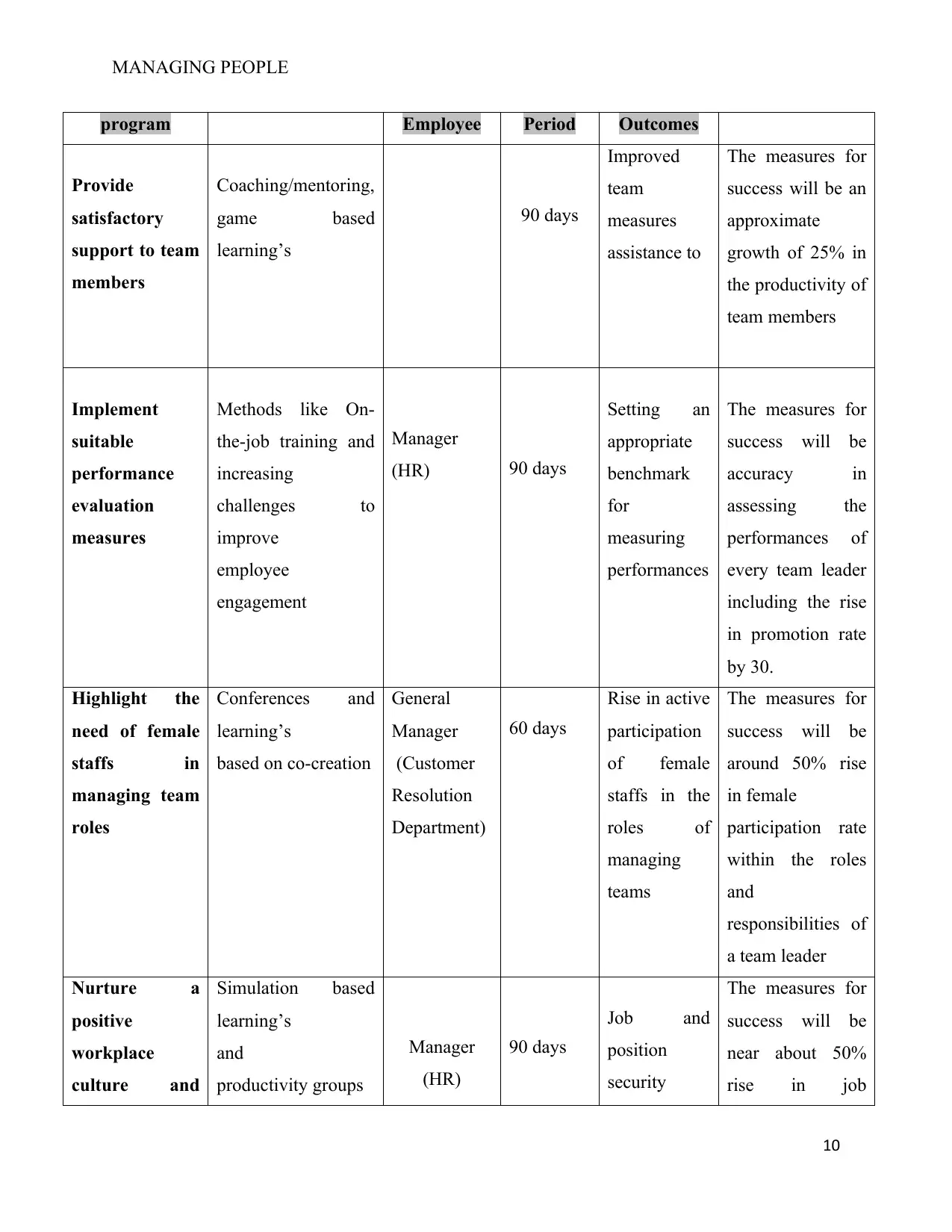
MANAGING PEOPLE
program Employee Period Outcomes
Provide
satisfactory
support to team
members
Coaching/mentoring,
game based
learning’s
90 days
Improved
team
measures
assistance to
The measures for
success will be an
approximate
growth of 25% in
the productivity of
team members
Implement
suitable
performance
evaluation
measures
Methods like On-
the-job training and
increasing
challenges to
improve
employee
engagement
Manager
(HR) 90 days
Setting an
appropriate
benchmark
for
measuring
performances
The measures for
success will be
accuracy in
assessing the
performances of
every team leader
including the rise
in promotion rate
by 30.
Highlight the
need of female
staffs in
managing team
roles
Conferences and
learning’s
based on co-creation
General
Manager
(Customer
Resolution
Department)
60 days
Rise in active
participation
of female
staffs in the
roles of
managing
teams
The measures for
success will be
around 50% rise
in female
participation rate
within the roles
and
responsibilities of
a team leader
Nurture a
positive
workplace
culture and
Simulation based
learning’s
and
productivity groups
Manager
(HR)
90 days
Job and
position
security
The measures for
success will be
near about 50%
rise in job
10
program Employee Period Outcomes
Provide
satisfactory
support to team
members
Coaching/mentoring,
game based
learning’s
90 days
Improved
team
measures
assistance to
The measures for
success will be an
approximate
growth of 25% in
the productivity of
team members
Implement
suitable
performance
evaluation
measures
Methods like On-
the-job training and
increasing
challenges to
improve
employee
engagement
Manager
(HR) 90 days
Setting an
appropriate
benchmark
for
measuring
performances
The measures for
success will be
accuracy in
assessing the
performances of
every team leader
including the rise
in promotion rate
by 30.
Highlight the
need of female
staffs in
managing team
roles
Conferences and
learning’s
based on co-creation
General
Manager
(Customer
Resolution
Department)
60 days
Rise in active
participation
of female
staffs in the
roles of
managing
teams
The measures for
success will be
around 50% rise
in female
participation rate
within the roles
and
responsibilities of
a team leader
Nurture a
positive
workplace
culture and
Simulation based
learning’s
and
productivity groups
Manager
(HR)
90 days
Job and
position
security
The measures for
success will be
near about 50%
rise in job
10
Secure Best Marks with AI Grader
Need help grading? Try our AI Grader for instant feedback on your assignments.
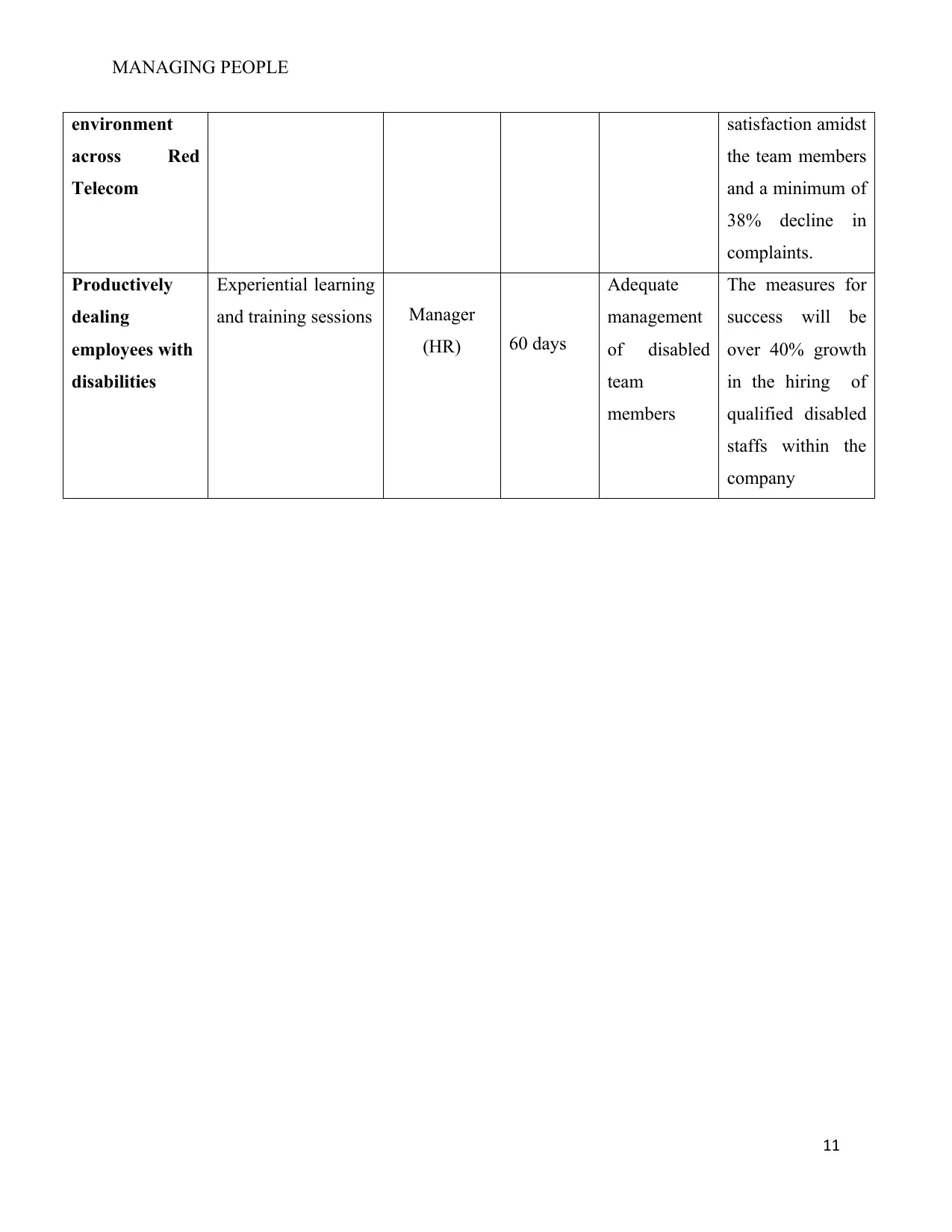
MANAGING PEOPLE
environment
across Red
Telecom
satisfaction amidst
the team members
and a minimum of
38% decline in
complaints.
Productively
dealing
employees with
disabilities
Experiential learning
and training sessions Manager
(HR) 60 days
Adequate
management
of disabled
team
members
The measures for
success will be
over 40% growth
in the hiring of
qualified disabled
staffs within the
company
11
environment
across Red
Telecom
satisfaction amidst
the team members
and a minimum of
38% decline in
complaints.
Productively
dealing
employees with
disabilities
Experiential learning
and training sessions Manager
(HR) 60 days
Adequate
management
of disabled
team
members
The measures for
success will be
over 40% growth
in the hiring of
qualified disabled
staffs within the
company
11
1 out of 11
Related Documents
Your All-in-One AI-Powered Toolkit for Academic Success.
+13062052269
info@desklib.com
Available 24*7 on WhatsApp / Email
![[object Object]](/_next/static/media/star-bottom.7253800d.svg)
Unlock your academic potential
© 2024 | Zucol Services PVT LTD | All rights reserved.



